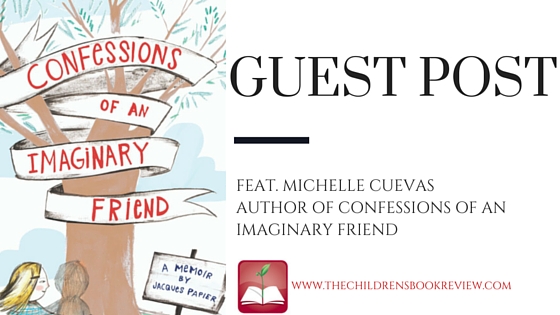Michelle Cuevas | The Children’s Book Review | September 9, 2015

I’ve always been intrigued by the imagined life of things. Dolls in their dollhouses, books on my bookshelf, and what my toys did when I was away at school. That last one was answered – quite beautifully might I add – by Margery Williams in her book The Velveteen Rabbit and, later, by the team at Pixar in their Toy Story films. I love the way these stories cause me to be drawn between two views of reality. But there are still so many imagined worlds left to explore… and the one I chose to dive into in my new novel, Confessions of an Imaginary Friend, is the imagined life of imaginary things. I wanted to hear the real story from the source, and so the book is an autobiography, written by one Jacques Papier, imaginary friend.
In the beginning Jacques, age eight, believes that he is just a normal, human boy disliked by all – teachers ignore him when he raises his hand, he is never chosen for sports teams, and even his parents need to be reminded to set a place for him at the dinner table. But soon, Jacques learns the truth: he is actually his sister Fleur’s imaginary friend. Cue existential crisis. Jacques goes on a journey that spans from joining Imaginaries Anonymous, a support group for imaginary friends, to discovering the wonder of belonging and being wholly himself.
One thing I learned is that if you write a fake autobiography, you have to find a way to truly get into the headspace of the memoirist. You must imagine their imaginary memories, hopes, and fears. I like this. It works well with my love of imagining the life of things. What would I do if I found out one day that I was imaginary and invisible? Where would I go? What would I want?
The strange thing is, it wasn’t that hard to relate. My research for the book was mostly thinking of all the times during my life that I too have felt invisible. We’ve all felt that feeling at some point – whether in a strange city or just lost in a parking garage – that sensation that we have somehow disappeared from the world. As Jacques asks at one point: “Who are you when there’s nobody around to remind you of your role? No memories to regret or keep you warm? What would you look like if you couldn’t remember ever looking like anything? What form would you take?”
When I was trying to get inside the mind of an imaginary person, I also wondered: if I were imaginary, what would I do to make myself less invisible? After some thought I realized that an amazing way to feel less invisible is to connect with another person. Jacques learns this eventually as well. He discovers that being giving and selfless is the path to feeling real.
I enjoyed my time in the imagined world of imaginary things. And if I ever get that lost-and-disappeared feeling again, I’ll just remember the mantra they repeat at the start of every meeting of Imaginaries Anonymous: You’re only as invisible as you feel, imaginary or not.
 Confessions of an Imaginary Friend
Confessions of an Imaginary Friend
Written by Michelle Cuevas
Publisher’s Synopsis: The whimsical “autobiography” of an imaginary friend who doesn’t know he’s imaginary—perfect for fans of The Miraculous Journey of Edward Tulane and Toy Story.
Jacques Papier has the sneaking suspicion that everyone except his sister Fleur hates him. Teachers ignore him when his hand is raised in class, he is never chosen for sports teams, and his parents often need to be reminded to set a place for him at the dinner table. But he is shocked when he finally learns the truth: He is Fleur’s imaginary friend! When he convinces Fleur to set him free, he begins a surprising, touching, and always funny quest to find himself—to figure out who Jacques Papier truly is, and where he belongs.
Readers will fall in love with Jacques’s sweet, quirky voice as he gives them a look at life from an incredible new perspective.
Ages 9-12 | Dial Books | 2015 | ISBN-13: 978-0525427551
Available Here:
About the Author
Michelle Cuevas graduated from Williams College and holds a master of fine arts degree in creative writing from the University of Virginia. She lives in Massachusetts.
Discover more books like Confessions of an Imaginary Friend, written by Michelle Cuevas, by checking out our reviews and articles tagged with Middle Grade Books and Writing Tips.
